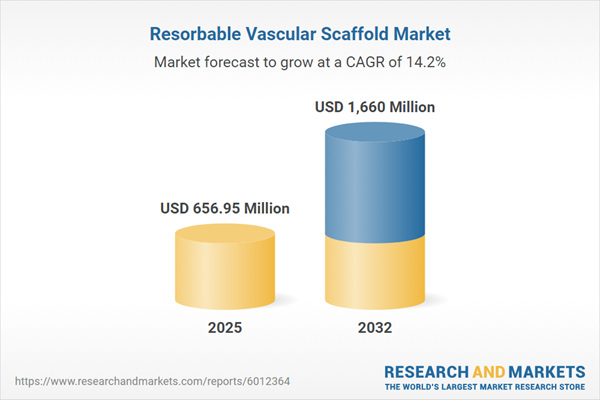Speak directly to the analyst to clarify any post sales queries you may have.
The resorbable vascular scaffold market is undergoing rapid transformation, driven by continuous innovation in material science, evolving stakeholder expectations, and increased clinical adoption across key global healthcare systems. Senior decision-makers in medtech, hospital network management, and manufacturing operations will find actionable intelligence in this in-depth analysis of market trends, competitive strategies, and future growth catalysts for resorbable vascular scaffolds.
Market Snapshot: Growth Trajectory and Competitive Context
The global resorbable vascular scaffold market grew from USD 576.57 million in 2024 to USD 656.95 million in 2025, advancing at a CAGR of 14.18% towards an expected USD 1.66 billion by 2032.
This sector’s expansion reflects increasing demand for patient-centric cardiovascular solutions and innovation in minimally invasive technologies that reduce chronic complications and optimize long-term clinical outcomes. Growth is further spurred by widespread validation from both mature and emerging healthcare economies, with intense R&D activity fueling next-generation product launches, new clinical protocols, and refined market access strategies.Scope & Segmentation: In-Depth Coverage of Key Market Drivers
This report offers comprehensive segmentation and analysis across the resorbable vascular scaffold landscape, addressing:
- Indication: Coronary artery disease (acute coronary syndrome and stable angina) and peripheral arterial disease (claudication, critical limb ischemia).
- Material: Magnesium-based scaffolds and polylactic acid constructs, each tailored for distinct healing profiles and anatomical complexities.
- End User: Ambulatory surgical centers, cardiac centers, and hospitals, spanning both outpatient and high-complexity care environments.
- Scaffold Diameter: Less than 3 millimeter and three millimeter and above, supporting personalized treatment strategies.
- Scaffold Length: Eighteen to twenty-eight millimeter, greater than twenty-eight millimeter, and less than eighteen millimeter, addressing a wide range of lesion types.
- Regions: Americas (North America and Latin America), Europe, Middle East & Africa, and Asia-Pacific, with detailed sub-regional and country-level analysis included.
- Company Landscape: Evaluation of strategic moves by Abbott Laboratories, Boston Scientific Corporation, Biotronik SE & Co. KG, Terumo Corporation, Meril Life Sciences Private Limited, Elixir Medical Corporation, Xeltis AG, Cardionovum GmbH, MicroPort Scientific Corporation, and Zorion Medical.
Key Takeaways for Senior Decision-Makers
- Resorbable vascular scaffolds are redefining interventional cardiology by minimizing the long-term risks associated with permanent implants and supporting vessel healing.
- Material innovation is driving differentiation, with magnesium and advanced polymers being optimized for strength, durability, and predictable resorption in targeted anatomies.
- Collaborative efforts between manufacturers and clinical research organizations are accelerating regulatory approvals, clinical implementation, and evidence-driven clinical adoption.
- Operational efficiencies and supply chain resilience have become critical as companies respond to shifting regulatory frameworks and complex global procurement challenges.
- Continuous advancement in delivery systems, imaging modalities, and real-world data analytics is empowering market leaders to offer tailored solutions for diverse end users and indications.
Tariff Impact: Navigating Regulatory Shifts in 2025
United States tariff adjustments in 2025 have prompted manufacturers to optimize global production footprints by increasing vertical integration and aligning with regional suppliers. Such strategies help ensure cost competitiveness, maintain supply continuity, and foster resilient networks that withstand regulatory changes and market fluctuations.
Methodology & Data Sources
This analysis utilizes a multi-tiered research approach by combining firsthand insights from in-depth interviews with clinical and industry experts and a systematic review of secondary sources, including peer-reviewed journals, patent filings, and regulatory documents. Data triangulation and scenario analysis underpin the accuracy and relevance of forecasts and recommendations.
Why This Report Matters: Empowering Strategic Decisions
- Enables leadership teams to benchmark innovation pipelines, assess competitive moves, and refine growth strategies within the resorbable vascular scaffold market.
- Informs procurement and supply chain leaders on best practices for operational resilience amidst shifting tariffs, manufacturing trends, and regional demands.
- Delivers clear, evidence-based insights that support strategic planning, product development, and investment allocation across clinical, commercial, and regulatory spheres.
Conclusion
With accelerating clinical adoption and technological innovation, the resorbable vascular scaffold sector is well-positioned for further expansion. Continued stakeholder alignment and operational agility will be essential for capitalizing on emerging opportunities and addressing evolving clinical needs.
Additional Product Information:
- Purchase of this report includes 1 year online access with quarterly updates.
- This report can be updated on request. Please contact our Customer Experience team using the Ask a Question widget on our website.
Table of Contents
3. Executive Summary
4. Market Overview
7. Cumulative Impact of Artificial Intelligence 2025
Companies Mentioned
The companies profiled in this Resorbable Vascular Scaffold market report include:- Abbott Laboratories
- Boston Scientific Corporation
- Biotronik SE & Co. KG
- Terumo Corporation
- Meril Life Sciences Private Limited
- Elixir Medical Corporation
- Xeltis AG
- Cardionovum GmbH
- MicroPort Scientific Corporation
- Zorion Medical
Table Information
| Report Attribute | Details |
|---|---|
| No. of Pages | 198 |
| Published | November 2025 |
| Forecast Period | 2025 - 2032 |
| Estimated Market Value ( USD | $ 656.95 Million |
| Forecasted Market Value ( USD | $ 1660 Million |
| Compound Annual Growth Rate | 14.1% |
| Regions Covered | Global |
| No. of Companies Mentioned | 11 |









